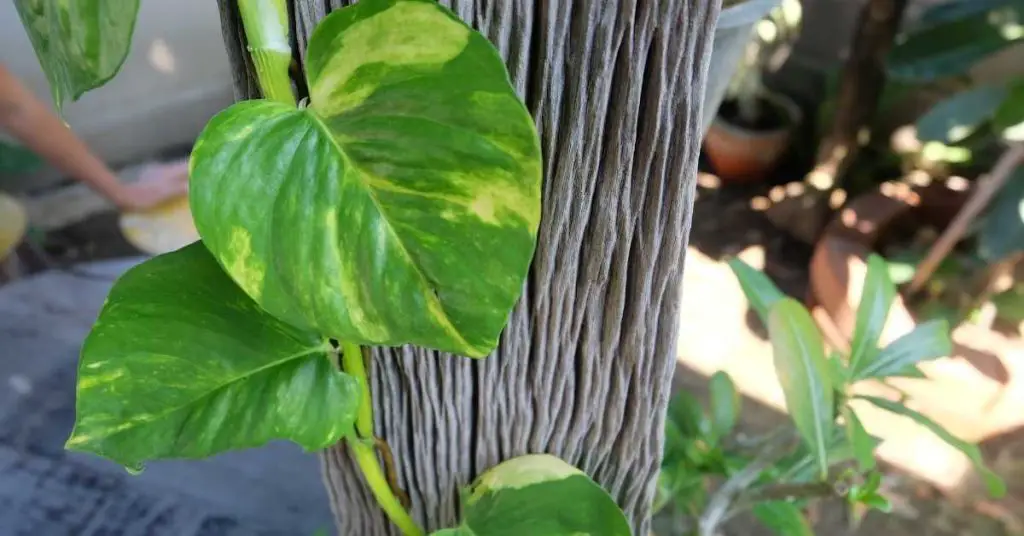What to Do with Aerial Roots on Pothos?
What to do with aerial roots on Pothos? Aerial roots growing from the stem of your pothos are actually natural so there is no need in doing anything with them. The pothos plant is a vine and likes to spread and thus produces these aerial roots when they start to spread or climb up an object. The roots help to take in moisture and nutrients along the way. However, if you do not like the look of them, you can remove them without hurting the plant.
Many people have aerial roots on their pothos plants and are not sure what to do with them. In fact, you probably have noticed them growing on your pothos plant.
This blog post will provide information on what to do with aerial roots on pothos plants.
What are Aerial Roots?
Aerial roots are one of the most distinctive and fascinating features of plants. These specialized roots grow above ground, often clinging to walls or other objects for support.
While they may look strange and unusual, aerial roots play an important role in the plant’s life cycle. In many cases, they help the plant climb and reach new heights. They also play an important role in absorbing water and nutrients from the air.
In some species, such as epiphytic orchids, aerial roots are also used for storage. While they may look like something out of a fairytale, aerial roots are a vital part of the plant world.

What are the functions of aerial roots?
Aerial roots are an amazing adaptation that allows plants to thrive in a variety of environments. These roots emerge from the plant’s stem and grow upward into the air. They are often seen in epiphytic plants, which grow on other plants or trees instead of in the ground.
Aerial roots help these plants anchor themselves and absorb moisture and nutrients from the air. In some cases, they also help to support the plant’s weight.
Furthermore, aerial roots can play an important role in propagating the plant. When they come into contact with moist soil, they can take root and form new plants.
As a result, aerial roots are a versatile tool that allows plants to survive and spread in a wide range of conditions.
What to do with aerial roots on Pothos?
First, you can simply leave them be so that they can help take in nutrients and water for the plant. Alternatively, you can trim them back if they are becoming too long or unsightly.
Finally, you can also use them to propagate new plants. Simply cut a section of stem with aerial roots attached and pot it up in moist soil. With a little care, it will soon take root and begin to grow.

What does it mean to have aerial roots?
Pothos plants are well known for their sprawling vines and their ability to tolerate a wide range of growing conditions. One distinctive feature of pothos plants is their aerial roots, which are roots that extended from the stems and grow out into the air.
While these roots may look strange, they are perfectly normal and serve an important purpose. Aerial roots help the plant climb vertical surfaces and anchor itself in place.
In addition, they help the plant to absorb moisture and nutrients from the air which helps the overall health of the plant. The more of these aerial roots you see, the better, they are a sign that your plant is thriving.
What causes Pothos to develop aerial roots?
There are a few different reasons why Pothos plants develop aerial roots. One reason is that the plant is searching for something to support it.
For example, if the plant is growing in a pot that is too small, the roots may start to grow out of the pot in order to find something to hold on to.
Another reason for aerial root development is that the plant is trying to reach more light. If the plant is not getting enough sunlight, the leaves may start to grow towards the light.
This can cause the roots to grow out of the pot and into the air in order to reach the light. If you cannot provide enough natural light for your plant then you can always get a grow light to supplement your plant.
Finally, some plants simply produce aerial roots because it is in their nature to do so.
My Plant Doesn’t Have Aerial Roots, Is there Something Wrong With It?
If your pothos doesn’t have any aerial roots, don’t worry – there’s nothing wrong with your plant! Aerial roots are simply roots that grow out of the stem of a plant, rather than growing down into the soil.
Some plants, like pothos, have aerial roots that help them to climb and attach themselves to surfaces. Other plants use aerial roots to absorb moisture from the air.
However, not all plants have aerial roots, and pothos plants can thrive without them. So if your pothos doesn’t have any aerial roots, don’t stress – your plant is perfectly healthy!

Are aerial roots beneficial?
These unusual roots serve a variety of purposes, depending on the type of plant they belong to.
For example, some vines use aerial roots to cling to walls and trees, while other plants use them to absorb moisture from the air.
Some epiphytic plants, which live in trees instead of in soil, also rely on aerial roots to absorb nutrients and water.
In general, aerial roots are adapted to help plants survive in difficult or unusual growing conditions.
Can you plant pothos aerial roots?
While pothos plants can be propagated from cuttings, many people wonder if it is possible to plant aerial roots.
However, it is not necessary to plant aerial roots in order to propagate a pothos plant. The roots will eventually take root on their own if they are left in moist soil.
In fact, it is often easier to propagate pothos plants from cuttings because the roots can be delicate and difficult to handle.
However, if you are patient and careful, you can successfully propagate a pothos plant from an aerial root.
Is it necessary to bury aerial roots?
Whether or not to bury aerial roots is entirely up to you. These roots, which grow above ground, are perfectly capable of taking in moisture and nutrients from the air.
However, some people prefer to bury them, as this can help the plant anchor itself more securely and prevent it from toppling over.
If you leave them unburied, they will eventually take root in the ground or in your pot all on their own.
Is it necessary to cut the aerial roots of Pothos?
It is not necessary to cut the aerial roots on your pothos. These roots serve the purpose of taking in air, water, and nutrients from the air for the plant to process.
In addition to this, they also provide stability for the plant as they will anchor to the ground, a tree, or even a wall.
Some people do trim these roots regularly to keep their plant tidy, looking good, or to stop it from growing too large.

Frequently Asked Questions (FAQs) about aerial roots on Pothos
Below are some frequently asked questions about Pothos aerial roots:
What is causing my Pothos to turn yellow?
There are a number of possible explanations for why your Pothos might be turning yellow. One possibility is that the plant is not getting enough light. Pothos thrive in bright, indirect light, so if it’s been placed in a shady spot, that could be the problem.
Another possibility is that the plant is getting too much water. Pothos like to have their soil moist but not soggy, so it’s important to let the top few inches of soil dry out before watering again.
Finally, it could be that the plant is suffering from a nutrient deficiency. If the leaves are yellowing and falling off, the problem might be a lack of iron. Yellowing with brown spots could indicate a lack of magnesium, while overall yellowing with stunted growth could mean a lack of nitrogen.
If you suspect that your plant is suffering from a nutrient deficiency, you can try fertilizing it with a balanced fertilizer formulated for Houseplants.
With a little trial and error, you should be able to figure out what’s causing the yellowing and get your Pothos back to its beautiful green self in no time!
How do I tell if my Pothos has root rot?
One of the most common problems that houseplants face is root rot. Root rot is caused by overwatering, and it can quickly kill a plant if left untreated.
So, how can you tell if your Pothos has root rot? There are a few telltale signs to look for. The leaves of a plant with root rot will often be wilted or yellow, even when the soil is moist. The stems may also be soft or mushy.
If you suspect that your plant has root rot, it’s important to take action immediately.
What should I do if my Pothos has root rot?
The best way to treat root rot is to allow the plant to dry out completely. Once the plant has dried out, you can replant it in fresh, well-draining soil. With a little care, your plant should recover and begin to thrive once again.
Be sure to fix your watering plan after you have replanted your pothos so that you do not make the same mistake again.
How can I train my Pothos to climb a stake?
Pothos are fast-growing vines that can quickly climb any support they can find. Given enough time, your Pothos will eventually make its way up a stake.
However, if you want to encourage your plant to climb sooner, there are a few things you can do.
First, choose a young, healthy plant. Pothos vines are naturally inclined to climb, but a younger plant will be more flexible and able to wrap around support more easily.
Second, use something that your Pothos can grab onto. Something like jute twine or a fishing line will work well. We like to give them a moss pole to climb on but pretty much anything you have will work.
Simply tie the vine to the support, making sure that the tie is loose enough that it won’t damage the plant.
Third, be patient. It may take some time for your Pothos to adjust to its new situation and start climbing. Once it does, you’ll have a beautiful, cascading plant that will add life to any room in your home.
In Conclusion
To recap, if your pothos plant has aerial roots, there is nothing to worry about. These roots that grow from the stems out into the air are perfectly normal and beneficial to the plant.
If for some reason you do not like them or you want to keep your plant looking more groomed, then feel free to snip them back with some clean scissors. It is up to you.
We hope this blog post has answered some of your questions about aerial roots on pothos. Thank you for reading.






